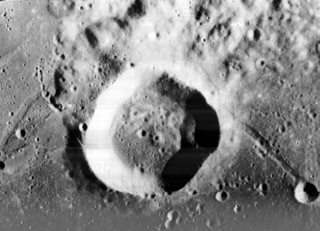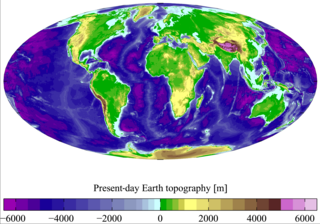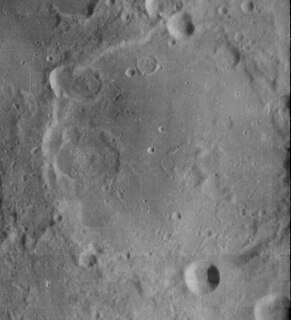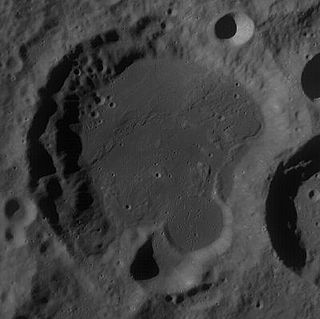 Lunar Orbiter 4 image | |
| Coordinates | 26°12′S5°54′E / 26.2°S 5.9°E Coordinates: 26°12′S5°54′E / 26.2°S 5.9°E |
|---|---|
| Diameter | 47 km |
| Depth | 1.6 km |
| Colongitude | 355° at sunrise |
| Eponym | Adam Johann von Krusenstern |
Krusenstern is a lunar impact crater that lies amidst the battered terrain in the southern part of the Moon's near side. Nearly attached to the east-southeast rim is the crater Apianus. Less than one crater diameter to the southwest is the prominent Werner. Krusenstern is intruding into a large circular plain to the north designated Playfair G. Playfair itself lies to the northeast.

Lunar craters are impact craters on Earth's Moon. The Moon's surface has many craters, almost all of which were formed by impacts.

An impact crater is an approximately circular depression in the surface of a planet, moon, or other solid body in the Solar System or elsewhere, formed by the hypervelocity impact of a smaller body. In contrast to volcanic craters, which result from explosion or internal collapse, impact craters typically have raised rims and floors that are lower in elevation than the surrounding terrain. Impact craters range from small, simple, bowl-shaped depressions to large, complex, multi-ringed impact basins. Meteor Crater is a well-known example of a small impact crater on Earth.

Terrain or relief involves the vertical and horizontal dimensions of land surface. The term bathymetry is used to describe underwater relief, while hypsometry studies terrain relative to sea level. The Latin word terra means "earth."
Krusenstern is 47 kilometers in diameter, and its walls reach a height of 1,600 meters. [1] [2] Its outer rim has been heavily worn by impact erosion, leaving an irregular ring of rising ridges and an inner wall incised by impacts. A joined pair of craters, including Krusenstern A, lie along the eastern rim. The interior floor of Krusenstern is a nearly featureless plain, marked only by a few tiny craterlets. [3] The crater is from the Pre-Nectarian period, 4.55 to 3.92 billion years ago. [1]
The Nectarian Period of the lunar geologic timescale runs from 3920 million years ago to 3850 million years ago. It is the period during which the Nectaris Basin and other major basins were formed by large impact events. Ejecta from Nectaris forms the upper part of the densely cratered terrain found in lunar highlands.
It is named after Adam Johann von Krusenstern, an early 19th-century Baltic German explorer in Russian service. [4] [1]

Adam Johann von Krusenstern was a Baltic German admiral and explorer, who led the first Russian circumnavigation of the globe.

Russia, officially the Russian Federation, is a transcontinental country in Eastern Europe and North Asia. At 17,125,200 square kilometres (6,612,100 sq mi), Russia is by a considerable margin the largest country in the world by area, covering more than one-eighth of the Earth's inhabited land area, and the ninth most populous, with about 146.77 million people as of 2019, including Crimea. About 77% of the population live in the western, European part of the country. Russia's capital, Moscow, is one of the largest cities in the world and the second largest city in Europe; other major cities include Saint Petersburg, Novosibirsk, Yekaterinburg and Nizhny Novgorod. Extending across the entirety of Northern Asia and much of Eastern Europe, Russia spans eleven time zones and incorporates a wide range of environments and landforms. From northwest to southeast, Russia shares land borders with Norway, Finland, Estonia, Latvia, Lithuania and Poland, Belarus, Ukraine, Georgia, Azerbaijan, Kazakhstan, China, Mongolia and North Korea. It shares maritime borders with Japan by the Sea of Okhotsk and the U.S. state of Alaska across the Bering Strait. However, Russia recognises two more countries that border it, Abkhazia and South Ossetia, both of which are internationally recognized as parts of Georgia.



















